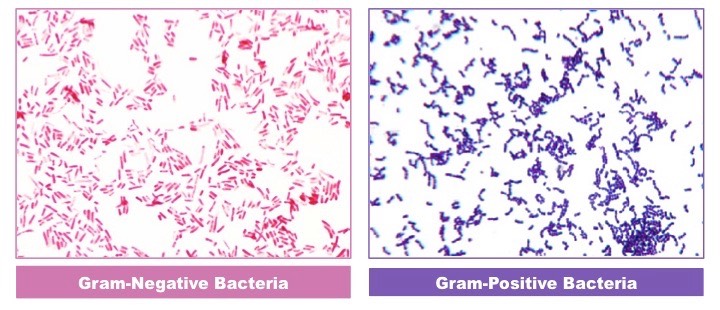![]()
Skill:
• Gram staining of Gram-positive and Gram-negative bacteria
Gram staining is a common technique used to differentiate between two groups of bacteria based on cell wall composition
- The Gram staining procedure will result in Gram-negative cells staining pink and Gram-positive cells staining purple
- The technique was developed by Danish bacteriologist Hans Christian Gram in 1884
Gram-Negative Versus Gram-Positive Bacteria

Cell Wall Composition
Gram staining identifies two different groups of bacteria based on the physical and chemical properties of their cell wall:
- Gram-positive bacteria generally have a single outer membrane surrounded by a thick layer of peptidoglycan
- Gram-negative bacteria generally possess a thin layer of peptidoglycan located between two outer membranes
Most bacterial phyla are typically Gram-negative, however many of the more prevalent bacterial genera are Gram-positive
- Examples of Gram-negative bacteria include cyanobacteria, salmonella and escherichia
- Examples of Gram-positive bacteria include bacillus, streptococcus and clostridium
- Some bacteria do not respond predictably to Gram staining (e.g. archaeans) and hence cannot be identified by staining
Gram-Negative Versus Gram-Positive Cell Walls

Staining Procedure
Gram staining of bacterial colonies involves four key steps:
- Heat-fixed cells are stained with crystal violet stain, which colours the cells purple
- Iodine solution is added, which forms a complex with the crystal violet stain and traps it within the cell
- Cells are washed with ethanol solution, which decolorises Gram-negative bacteria (but not Gram-positive)
- Gram-negative cells are visualised by applying safranin – which is a pink-coloured counterstain
Gram staining works as a result of the different effects of ethanol on the cell wall of the bacteria:
- Gram-positive bacteria have a thick peptidoglycan layer which is dehydrated by ethanol, trapping the crystal violet stain
- Gram-negative bacteria have an outer lipid membrane which is dissolved by ethanol, releasing the crystal violet stain
Both cell types retain the counterstain, but the pink colour cannot be distinguished in the purple-stained Gram-positive cells
Gram Staining Technique

